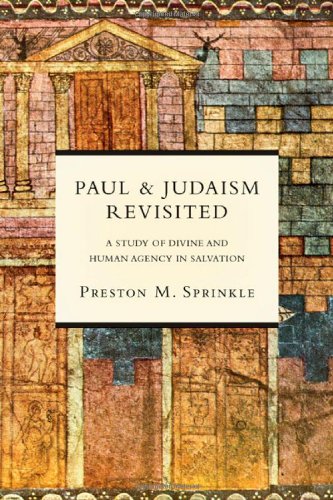A Brief Book Summary from Books at a Glance
By Mark Baker
About the Author
Preston Sprinkle (PhD, University of Aberdeen) is associate professor of biblical studies at Eternity Bible College, Simi Valley, California. He has authored or co-authored several books on Paul and specializes in Paul’s relationship with Judaism.
Overview
Our view of Paul’s letters is often determined by what we think of his relationship with Judaism. How does Paul view his “former life” in Judaism? How does Paul relate with Jewish writers in the 1st century? Is there any overlap between Paul’s theology and the theology represented in the Dead Sea Scrolls that were discovered at Qumran? This book attempts to answer some of these questions by looking specifically at the topic of divine and human agency in salvation. Though this study finds both continuity and discontinuity between Paul and the Qumran documents, the fundamental claim of the book is that there is more discontinuity than continuity.
Contents
Foreward by Stephen Westerholm
Preface
Chapter 1: Paul and Judaism Revisited
Chapter 2: Deuteronomic and Prophetic Restoration
Chapter 3: Restoration from the Curse of the Law
Chapter 4: The Eschatological Spirit
Excursus: Moses, Paul and the Glory of the Old and New Covenants
Chapter 5: Anthropological Pessimism in Paul and Qumran
Chapter 6: Justification in Paul and Qumran
Chapter 7: Judgment According to Works
Excursus: Justification by Grace and Future Judgment Not by Grace?
Chapter 8: Divine and Human Agency in Early Judaism: A Survey
Chapter 9: Paul and Judaism: Soteriology Revisited
Chapter 1: Paul and Judaism Revisited
What is the topic of “Paul and Judaism,” and why does it need to be revisited? At first glance, the phrase might seem odd. After all, wasn’t Paul a Jew? Though the case can be made that Paul never stopped being “Jewish” after his conversion, it would be best to call him an “idiosyncratic Jew,” because his new view of Jesus as the Messiah would put him at odds with much of the Jewish community.
Frankly, “Paul and Judaism” needs to be revisited because of the current state of scholarship in this area. E.P. Sanders significantly altered the conversation with his 1977 book, Paul and Palestinian Judaism. Sanders’ famous conclusion was that the problem with Judaism was that it was simply “not Christianity.” James D.G. Dunn added his voice, arguing that the problem with Judaism was not legalism but ethnocentrism. N.T. Wright became another notable contributor, claiming that Paul’s doctrine of justification was “not at the core of Paul’s thought but was a polemical doctrine aimed at Jewish national pride” (24).
Sanders, Dunn, and Wright are three major players in a movement that has come to be called “The New Perspective on Paul.” These three are by no means monolithic in their conclusions, but there is one strand that ties them all together: continuity. They all hold to a significant amount of continuity between Paul’s soteriology and Judaism’s. Here “soteriology,” is used to refer to “the restoration God brings to those who belong to his covenant community” (34).
The continuity or discontinuity between Paul and Judaism is the crux of the issue. This book will examine this question specifically in regard to Paul and the Dead Sea Scrolls, and it will examine five themes that are central to both Paul and Qumran:
(1) the curse of the old covenant and how God will rescue his people from it;
(2) the nature of the eschatological spirit’s work among the community;
(3) the view of the human condition, which among both Paul and Qumran amounts to a degree of anthropological pessimism;
(4) justification—how the community members attain the status of righteous before a righteous God; and
(5) the relationship between future judgment and works for those who are part of the covenant community. (34)
Chapter 2: Deuteronomic and Prophetic Restoration
Before looking at Paul and Qumran specifically, we need to outline the way the Old Testament views salvation. A careful look at the Old Testament reveals that there are two “programs of restoration” that are distinct, yet not contradictory. The first is called Deuteronomic. It refers to the concept of retribution that is often given in Deuteronomy: If Israel repents and obeys the law then God will restore Israel. The second is called Prophetic. This pattern highlights humankind’s propensity to sin and therefore emphasizes God’s unilateral work of restoration.
The Deuteronomic pattern, beyond Deuteronomy itself, is found most clearly in Ezra, Nehemiah, and Chronicles. These books focus on the need for Israel to repent from idolatry and to turn to the law. These books uses words such as “humble (oneself),” “pray,” “seek,” and “turn” to link to the promise of God’s reward for the obedient that are given in Deuteronomy. The depiction of Rehoboam’s obedience stands out as a prime example. Chronicles mentions “that Rehaboam is awarded covenant blessings for his obedience: prosperity and power (2 Chron 11:5–12), support from the populace (2 Chron 11:13–17), and progeny (2 Chron 11:18–22), all of which are left out by Kings” (45).
The Prophetic pattern can be seen most clearly in Isaiah, Jeremiah, and Ezekiel. In contrast to the exhortation of the Deuteronomic pattern, these books. . .
[To continue reading this summary, please see below....]The remainder of this article is premium content. Become a member to continue reading.
Already have an account? Sign In
